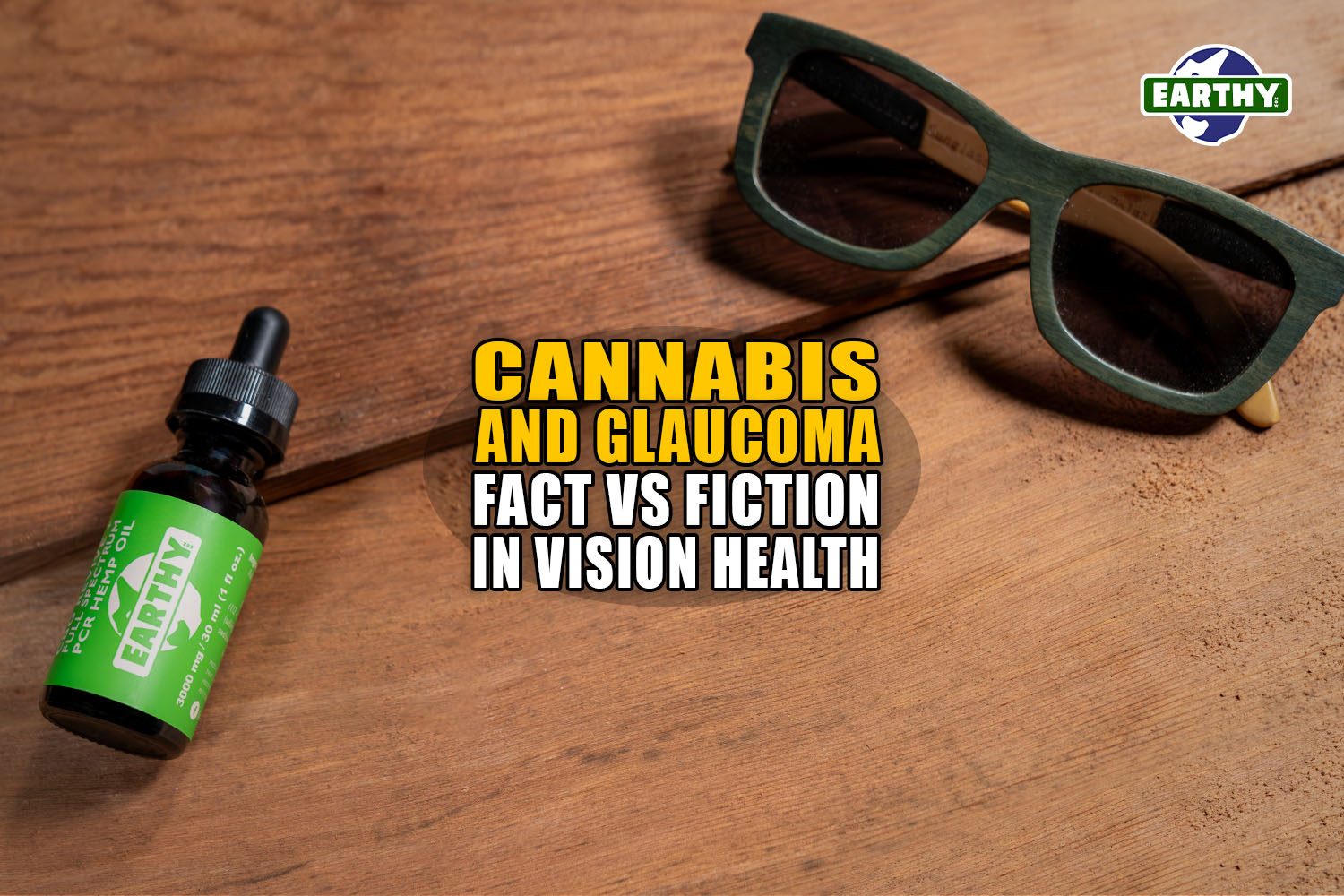Glaucoma is a group of eye conditions that damage the optic nerve, often due to elevated intraocular pressure (IOP). It’s a leading cause of blindness worldwide, particularly among older adults [1]. Given the seriousness of glaucoma, patients and healthcare providers continuously seek effective treatments. One controversial topic in glaucoma therapy is the use of cannabis, specifically its potential to lower IOP and treat glaucoma [2]. This article aims to separate fact from fiction in the use of cannabis for glaucoma management.
Understanding glaucoma
Glaucoma usually manifests as primary open-angle glaucoma, characterized by gradual loss of peripheral vision. Sadly, the disease progresses silently, with most patients unaware of their condition until significant vision loss occurs. According to studies, elevated IOP is a major risk factor for glaucoma, which ultimately leads to optic nerve damage. Traditional glaucoma treatment includes eye drops, oral medications, laser treatments, and surgical interventions, all aimed at reducing IOP [1].
The Role of Cannabis in Modern Medicine
Cannabis and its components
Cannabis, commonly known as marijuana or hemp depending on the amount of Delta-9 THC in the plant, contains numerous active compounds. For example, cannabis contains cannabinoids such as delta-9-tetrahydrocannabinol (THC) and cannabidiol (CBD). These cannabinoids interact with cannabinoid receptors in the human endocannabinoid system (ECS), influencing various physiological processes [3].
Early studies suggested that consuming or smoking cannabis might have serious potential as a glaucoma treatment [4]. However, these studies are controversial and medical experts point out potential problems with the findings.
The effects of cannabis on intraocular pressure
Early studies and anecdotal evidence
The notion that cannabis lowers IOP originates from research in the 1970s, where studies indicated that smoking marijuana could temporarily reduce IOP by approximately 25%. These findings generated excitement but also controversy due to the psychotropic effects of THC from marijuana and the common method of administration—smoking [4].
Recent research and findings
More recent scientific research has provided a nuanced view of cannabis and its ocular effects. For example, some studies reinforce the IOP-lowering potential of THC, while others highlight limitations and concerns. Notably, positive influence – where observed – is often short-lived, lasting only a few hours, which necessitates frequent dosing. Moreover, the psychotropic effects of THC make it impractical for regular use for many people. It’s crucial for those hoping to treat glaucoma symptoms with cannabis to consult their physician for medical advice.
Potential benefits of cannabis for glaucoma patients
Symptom management and neuroprotection
Apart from the research into its potential to lower IOP, cannabis may offer other benefits for glaucoma patients. For example, some evidence suggests that cannabinoids like CBD may possess properties that may potentially help safeguard sufferers [6]. However, the FDA has not fully explored or approved this theory. Indeed, only one CBD-based drug has been approved by the FDA thus far, and that is one for severe, rare epilepsy (the FDA-approved drug is Epidiolex) [7]. Though various forms of medical marijuana have been examined to treat eye conditions, especially glaucoma, newer research suggests that CBD may not be an effective treatment for your eyes [8].
Even so, cannabis’s potential to promote overall wellness can enhance the quality of life for people suffering from many chronic conditions [9].
Cannabis and PTSD: Shedding Light on a Complex Situation
Administration methods
Cannabis can be administered in various ways, including inhaled cannabis smoke or vapor, topical administration (such as THC eye drops), and sublingual application. It’s important to note that THC eye drops have been studied as a potential treatment for a rare eye condition that causes the muscles around the eyes and eyelids to spasm uncontrollably (benign essential blepharospasm) [10].
CBD and the FDA: How Cannabidiol is Regulated
Risks and side effects of cannabis use
Short-term and long-term effects
Cannabis use is not without risks. For example, short-term side effects include cognitive impairment, dry mouth, and even potential exacerbation of glaucoma symptoms. In addition, long-term use raises concerns about respiratory issues (from smoking), dependency, and potential interactions with glaucoma medications [11].
Interaction with existing treatments
Cannabis may interact with conventional glaucoma medications, complicating the management of the disease [5]. Therefore, it’s crucial for patients to seek an ophthalmologist’s advice before incorporating cannabis into their wellness regimen.
Cannabis and Alzheimer’s: Helpful or Harmful?
Myths and misconceptions
Cannabis as a cure
One common myth is that cannabis can cure glaucoma. While it may provide temporary quality of life improvements for some, it does not address the underlying causes of the disease or prevent vision loss in the long term [5].
Misunderstandings about efficacy
There’s also a misconception that all forms of cannabis are equally effective. In reality, the effectiveness varies significantly depending on the strain, dosage, and method of administration [12]. Therefore, patients should consult an ophthalmologist for a customized treatment plan for glaucoma, which may or may not include cannabis.
Consequences of Getting a Medical Card: Is It Worth It?
The role of scientific research
Current studies and future directions
Ongoing research aims to clarify the role of cannabinoids in glaucoma therapy. For example, studies like the “Multiple Drop Study” and pilot studies on topical administration of cannabinoids are crucial for understanding their potential benefits and limitations [13]. Notably, the National Eye Institute and National Academies have emphasized the need for more research to establish safe and effective treatment protocols [14].
Recommendations for patients
Glaucoma patients should prioritize established treatments while staying informed about emerging therapies. For example, effective treatments for glaucoma sometimes involve lowering IOP through medications like eye drops or surgeries that improve drainage in the trabecular meshwork [15]. Thus, consulting with a glaucoma specialist is essential for tailored treatment plans.
Sex and the Endocannabinoid System: Chemistry in the Bedroom
Cannabis for overall wellness and uplift
For those seeking reliable, trustworthy sources for hemp-derived cannabis products, Earthy Now has something for everyone. These products provide the industry’s cleanest and strongest CBD, CBN, CBG, CBC, CBDv, and CBDa products, with only trace amounts of Delta-9 THC (no more than 0.3%). As always, Earthy Now provides the optimal balance of cannabinoids while ensuring low Delta-9 THC levels per federal guidelines. As a result, customers report various beneficial effects, from clear-headed alertness and energy to relaxation.
Explore these natural products to boost wellness:
- Gummies
- Lozenges
- Tablets (THC Free!)
- Soothing Relief Lotion
- Soothing Relief Salve
- Oils
- Flower
- Pet Products (THC Free!)
- Pre-Rolls
- Smokes
Key takeaway: cannabis and glaucoma
Cannabis presents both potential benefits and risks for glaucoma patients. Scientific research continues to explore its potential. But for now, conventional glaucoma treatments remain the most reliable way to manage and control glaucoma.
In summary, while cannabis shows promise in the realm of future glaucoma therapy, it’s not a cure-all. Patients should rely on their ophthalmologists and current medical guidelines to navigate their treatment options effectively. The hope for future research is to find ways to harness the benefits of cannabinoids without compromising patient safety or treatment efficacy.
Visit Earthy Now for a wide variety of cannabis smokes, topicals, and edibles for elevated wellness!
Medical Disclaimer / Legal Disclaimer – Information is provided for educational purposes. It does not and is not intended to constitute legal advice or medical advice. We attempt to be accurate and up-to-date, but the legality of cannabinoids and the science of cannabis are evolving. The author is neither a legal professional nor a medical expert. Before buying or using any products, you should check with your local authorities and medical providers.
References
- What is Glaucoma?
- Does Marijuana Help Glaucoma?
- Cannabis and Glaucoma
- Cannabis, Glaucoma, and Intraocular Pressure
- Why Eye Doctors Don’t Recommend Marijuana for Glaucoma
- Cannabidiol’s Neuroprotective Properties
- Epidiolex
- Studies Look at the Effects of Marijuana on Vision
- 7 Potential Health Benefits of Cannabis
- Cannabis-Infused Eye Drops May Treat Rare Eye Condition
- Marijuana Use and Its Effects
- Best Cannabis Strains for Glaucoma
- Multiple-Drop Study of Topically Applied 1% Δ9-Tetrahydrocannabinol in Human Eyes
- Glaucoma and Marijuana Use
- The Role of the Trabecular Meshwork in Eye Fluid Drainage




 Earthy Now
Earthy Now Earthy Now
Earthy Now